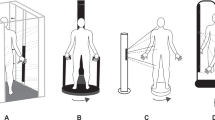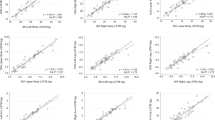Abstract
Objective: Changes in skeletal muscle mass are involved in several important clinical disorders including sarcopenia and obesity. Unlike body fat, skeletal muscle is difficult to quantify in vivo, particularly without highly specialized equipment. The present study had a two-fold aim: to develop a regional 40K counter for non-invasively estimating cell mass in the arm, mainly skeletal muscle cell mass, without radiation exposure; and to test the hypothesis that cell mass in the arm is highly correlated with electrical impedance after adjusting for the arm's length.
Methods: Forearm cell mass was estimated using a rectangular lead-shielded 40K counter with 4-NaI crystals; impedance of the arm was measured at multiple frequencies using a segmental bioimpedance analysis (BIA) system. The system's within- and between-day coefficient of variation (CV) for 40K-derived elemental potassium averaged 1.8±1.3 and 5.8±1.2%, respectively. The corresponding BIA system's CVs were 1.0±0.4 and 2.1±1.0%, respectively.
Subjects and results: Participants in the study were 15 healthy adults (eight females, seven males; age 39±2.8 y, BMI 22.9±4.5 kg/m2). The right arm's K (5.2±1.7 g) was highly correlated with length-adjusted impedance (r2=0.81, 0.82, and 0.83 for 5, 50 and 300 kHz, respectively; all P<0.001); multiple regression analysis showed no additional improvement by adding age or sex to the prediction models.
Conclusion: These results demonstrate the feasibility of calibrating BIA-measured electrical properties of the arm against estimates of arm cell mass, mainly of skeletal muscle, obtained by regional 40K counting. This simple and practical approach should facilitate the development of BIA-based regional cell mass prediction formulas.
Sponsorship: National Institutes of Health grants RR00645 and NIDDK 42618.
This is a preview of subscription content, access via your institution
Access options
Subscribe to this journal
Receive 12 print issues and online access
$259.00 per year
only $21.58 per issue
Buy this article
- Purchase on Springer Link
- Instant access to full article PDF
Prices may be subject to local taxes which are calculated during checkout



Similar content being viewed by others
References
Baumgartner RN, Chumlea WC, Roche AF . 1989 Estimation of body composition from bioelectric impedance of body segments Am. J. Clin. Nutr. 50: 221–226
Brown BH, Karatzas T, Nakielny R, Clarke RG . 1988 Determination of upper arm muscle and fat areas using electrical impedance measurements Clin. Phys. Physiol. Meas. 9: 47–55
De Lorenzo A, Andreoli A, Matthie J, Withers P . 1997 Predicting body cell mass with bioimpedance by using theoretical methods: a technological review J. Appl. Physiol. 82: 1542–1558
Elia M, Fuller NJ, Hardingham CR, Graves M, Screaton N, Dixon AK, Ward LC . 2000 Modeling leg section by bioelectrical impedance analysis, dual energy X-ray absorptiometry, and anthropometry: assessing segmental muscle volume using magnetic resonance imaging as reference Ann. NY Acad. Sci. 904: 298–305
Ellis HJ . 2000 Human body composition: in vivo methods Physiol. Rev. 80: 649–680
Gallagher D, Visser M, De Meersman RE, Sepúlveda D, Baumgartner RN, Pierson RN Jr, Harris T, Heymsfield SB . 1997 Appendicular skeletal muscle mass: effects of age, gender, and ethnicity J. Appl. Physiol. 82: 229–239
Heymsfield SB, Gallagher D, Grammes J, Nunez C, Wang ZM, Pietrobelli A . 1998 Upper extremity skeletal muscle mass: potential of measurement with single frequency bioimpedance analysis Appl. Radiat. Isot. 49: 473–474
Lee RC, Wang ZM, Heo M, Ross R, Janssen I, Heymsfield SB . 2000 Total-body skeletal muscle mass: development and cross validation of anthropometric prediction models Am. J. Clin. Nutr. 72: 796–803
Lee RC, Wang ZM, Heymsfield SB . 2001 Skeletal muscle mass and aging: regional and whole body measurements methods Can. J. Appl. Physiol. 26: 102–122
Lexell J . 1995 Human aging, muscle mass, and fiber type composition J. Gerontol. 50A: 11–16
Lexell J, Downham D, Sjostrom M . 1986 Distribution of different fibre types in human skeletal muscles. Fibre type arrangement in m. vastus lateralis from three groups of healthy men between 15 and 83 y J. Neurol. Sci. 72: 211–222
Lukaski HC . 2000 Assessing regional muscle mass with segmental measurements of bioelectrical impedance in obese women during weight loss Ann. NY Acad. Sci. 904: 154–158
Malina RM . 1996 Regional body composition: age, sex, and ethnic variation In: Human Body Composition eds. AF Roche, SB Heymsfield & TG Lohman, pp 217–256 Human Kinetics: Champaign, IL
Mitsiopoulos N, Baumgartner RN, Heymsfield SB, Lyons W, Ross R . 1998 Cadaver validation of skeletal muscle measurements by magnetic resonance imaging and computerized tomography J. Appl. Physiol. 85: 115–122
Moore FD, Olesen KH, McMurray JD, Parker M, Ball R, Boyden CM . 1963 The Body Cell Mass and its Supporting Environment Philadelphia, PA: Saunders
Nuñez C, Gallagher D, Grammes J, Baumgartner RN, Ross R, Wang ZM, Thornton J, Heymsfield SB . 1999 Bioimpedance analysis: potential for measuring lower limb skeletal muscle mass J. Parental. Enteral Nutr. 23: 96–103
Nuñez C, Zingaretti G, Kassis N, Mizer K, Fielding R, Heo M, Heshka S, Heymsfield SB . 2001 Bioimpedance analysis: skeletal muscle specific resistivity is not constant as assumed but changes with experimentally-induced skeletal muscle atrophy FASEB J 15: A1002
Organ LW, Bradham GB, Gore DT, Lozier SL . 1994 Segmental bioelectrical impedance analysis: theory and application of a new technique J. Appl. Physiol. 77: 98–112
Pietrobelli A, Morini P, Battistini N, Chiumello G, Nuñez C, Heymsfield SB . 1998 Appendicular skeletal muscle mass: prediction from multiple frequency segmental bioimpedance analysis Eur. J. Clin. Nutr. 52: 507–511
Selberg O, Buchert W, Graubner G, Wenner C, Ehrenheim C, Muller J . 1993 Determination of anatomical skeletal muscle mass by whole-body nuclear magnetic resonance In: Human Body Composition, In Vivo Methods, Models, and Assessment ed. KJ Ellis & Eastman JD pp 95–97 New York: Plenum Press
Shih R, Wang ZM, Heo M, Wang W, Heymsfield SB . 2000 Lower limb skeletal mass: development of dual-energy X-ray absorptiometry prediction model J. Appl. Physiol. 89: 1380–1386
Sjöstrom L . 1991 A computer-tomography based multicomponent body composition technique and anthropometric predictions of lean body mass, total and subcutaneous adipose tissue Int. J. Obes. 15: 19–30
Snyder WS, Cook MJ, Nasset ES, Karhausen LR, Howells GP, Tipton IH . 1975 Report of the Task Group on Reference Man Oxford: Pergamon Press
Spiers FW . 1961 Whole-body counting: an introductory review In: Symposium on Whole-Body Counting Vienna: International Atomic Energy Agency
Yasumura . 1999 Correlation of forearm and bioelectrical impedance analysis (BIA)-derived fat-free mass (FFM) in the arms of normal individuals FASEB J. 223: 1
Acknowledgements
The authors extend their appreciation to Dr Corrado Testolin who participated in the early planning stages of this project and to Drs Moonseong Heo and Myles Faith who provided statistical guidance.
Author information
Authors and Affiliations
Corresponding author
Rights and permissions
About this article
Cite this article
Pietrobelli, A., Nuñez, C., Zingaretti, G. et al. Assessment by bioimpedance of forearm cell mass: a new approach to calibration. Eur J Clin Nutr 56, 723–728 (2002). https://doi.org/10.1038/sj.ejcn.1601384
Received:
Revised:
Accepted:
Published:
Issue Date:
DOI: https://doi.org/10.1038/sj.ejcn.1601384
Keywords
This article is cited by
-
Accuracy of segmental multi-frequency bioelectrical impedance analysis for assessing whole-body and appendicular fat mass and lean soft tissue mass in frail women aged 75 years and older
European Journal of Clinical Nutrition (2013)
-
New bioimpedance analysis system: improved phenotyping with whole-body analysis
European Journal of Clinical Nutrition (2004)



